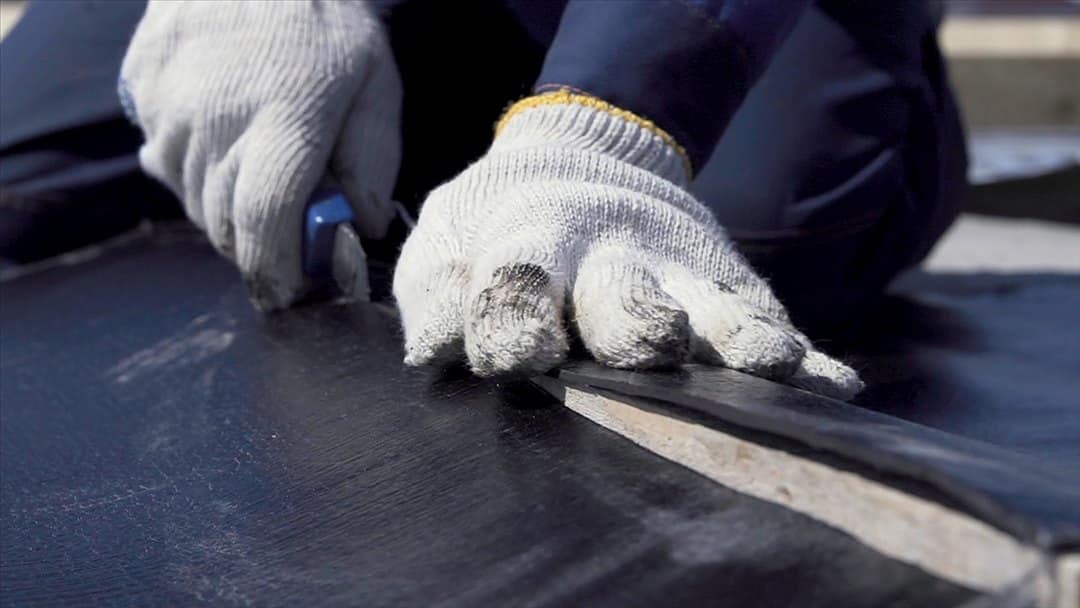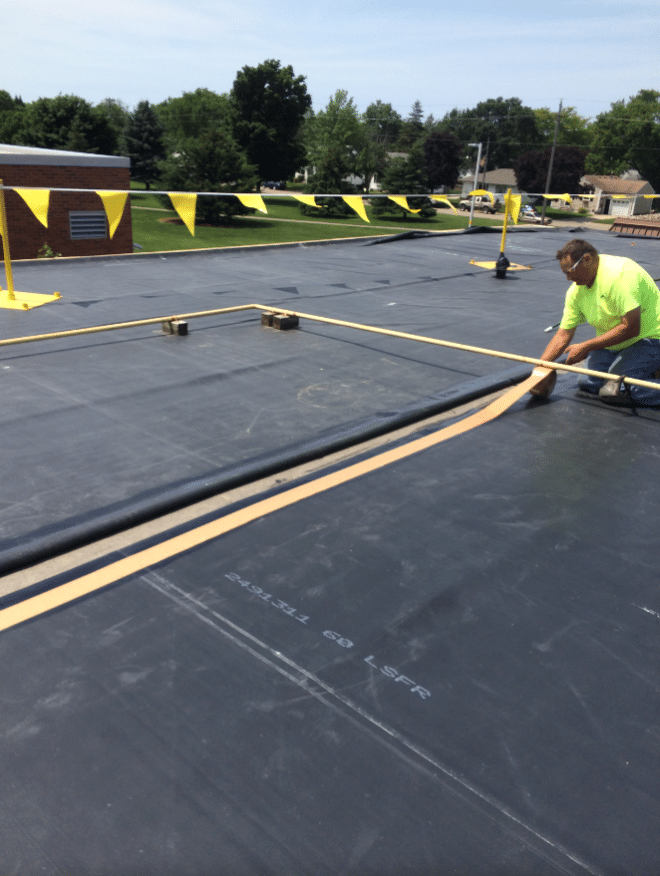When it comes to choosing a new commercial roofing system, EPDM (ethylene propylene diene monomer) roofing is a popular and reliable option worth considering. It is an economic and sustainable choice because of its low installation cost and lifetime economic value, durability, installation ease, design flexibility, and recyclability.
However, before you make your decision, it’s important to understand what EPDM roofing system is, how it works, and what benefits it can offer your property. In this article, we’ll cover five key things you should know about EPDM roofing to help you make an informed decision for your commercial roofing needs.
#1 – What is a EPDM Roofing System, and How Does It Work?
EPDM roofing is a type of synthetic rubber membrane commonly used in commercial roofing applications. The material is made from a blend of ethylene and propylene and created using a high-pressure steam process. This process results in a strong, durable, and flexible membrane that is resistant to UV radiation and weathering.
This commercial roofing material is typically sold in large rolls that can be cut to fit the specific roof dimensions. It is available in different thicknesses, ranging from 45 to 90 millimeters. The thickness of the membrane depends on the building’s size, the local climate, and other factors.
There are two methods for installing EPDM roofing: the fully adhered method and the mechanically attached method. The fully adhered method involves gluing the membrane to the roof substrate using a special adhesive. The mechanically attached method involves securing the membrane to the roof substrate using mechanical fasteners.
#2 – The Benefits of EPDM for Your Commercial Property

EPDM roofing is an excellent choice for commercial properties for a variety of reasons. Here are some of the key benefits:
- Cost-effective: EPDM roofing is one of the most cost-effective roofing materials on the market. It’s affordable to install and requires very little maintenance over its long lifespan, making it a smart investment for any property owner.
- Minimal maintenance: Unlike other types of roofing materials, EPDM requires minimal maintenance. It doesn’t require frequent cleaning or treatment, which saves property owners both time and money.
- Long lifespan: EPDM roofing can last up to 50 years with proper installation and maintenance. This makes it a durable and long-lasting option that provides excellent value for property owners.
- Energy-saving: The roofing material is energy-saving due to its reflective properties. It can reflect heat from the sun, reducing the amount of energy needed to cool the building. This can lead to significant cost savings on energy bills over time.
#3 – Types of EPDM Roofing and Which One is Right for You
There are two types of EPDM roofing: black EPDM and white EPDM. Black EPDM is the more commonly used type. It is suitable for most commercial roofs. It’s less expensive than white EPDM, making it an excellent choice for commercial properties with budget constraints.
On the other hand, white EPDM is used for roofs that require reflective properties. White EPDM can reflect up to 85% of the sun’s rays. It’s an excellent choice for commercial properties in warm climates. Reflective roofs can reduce the amount of heat absorbed by the building, which can lower cooling costs and reduce energy consumption.
#4 – The EPDM Roofing System Installation Process: What to Expect

The installation process of EPDM roofing is quite straightforward, but it requires some preparation and expertise to ensure that the roofing system is installed properly. The following steps are generally involved in installing EPDM roofing:
- Preparation: Before installing the EPDM roofing, you need to have the old roof removed and any underlying damage repaired. The roof substrate should be clean, dry, and free of any debris. If the substrate is not in good condition, you may need to have it repaired or replaced.
- Membrane Layout: The installer lays the EPDM roofing membrane over the roof substrate. Then, he allows the membrane to relax. He also smooths out any wrinkles or bubbles.
- Adhesive Application: Once the membrane is laid out, the installer applies an adhesive. There are two types of adhesive commonly used in EPDM roofing installation: water-based and solvent-based. Water-based adhesive is generally easier to work with, but it may not be suitable for all applications. Solvent-based adhesive is more versatile and can be used in a wider range of temperatures and climates.
- Membrane Application: The installer rolls out the EPDM membrane onto the adhesive. Then, he carefully aligns the membrane to ensure that it is straight and centered on the roof substrate. Afterwards, he carefully rolls out and smooths the membrane to eliminate any wrinkles or bubbles.
- Finishing Edges: Once the membrane is in place, the installer finishes the edges. This involves trimming the membrane to the appropriate size and securing it to the roof substrate. He seals the edges using an adhesive and a sealant.
- Inspection: After the installation is complete, the installer inspects the EPDM roofing system to ensure that it is installed properly. This includes checking for any gaps or seams that are not properly sealed.
#5 – Maintaining Your EPDM Roof: Tips and Best Practices
EPDM roofing is a durable and long-lasting roofing material that requires minimal maintenance. However, regular inspections and cleaning can help ensure that the roofing system lasts as long as possible.
Here are some tips for maintaining your EPDM roofing system:
- Inspections: Inspect your EPDM roofing regularly to identify any damage or issues. Look for signs of cracking, tears, or punctures. Check the seams and edges for signs of separation or lifting. If you notice any problems, contact a qualified roofing contractor to make repairs.
- Cleaning: Clean your EPDM roofing system regularly to remove any debris, dirt, or pollutants. Use a mild detergent and a soft-bristle brush to clean the surface of the roofing system. Avoid using harsh chemicals or abrasive cleaners that can damage the membrane.
- Repairs: If you notice any damage to your EPDM roofing system, contact a qualified roofing contractor to make repairs. Attempting a DIY repair can result in further damage and may void the warranty.
- Avoid Walking on the Roof: EPDM roofing systems can be damaged by foot traffic. Avoid walking on the roof as much as possible. If you need to access the roof, use a ladder and take care not to damage the EPDM membrane.
- Work with a Qualified Contractor: When installing or repairing your EPDM roofing system, work with a qualified roofing contractor who has experience with EPDM roofing. This will ensure that the roofing system is installed or repaired properly and help prevent future issues. Moreover, it will extend the lifespan of the roofing system.
Ready to Install an EPDM Roofing System on Your Commercial Property?
If you’re considering an EPDM roofing system for your commercial property, it’s important to work with a trusted and experienced roofing contractor. Allweather Roof is a reputable commercial roofing company that provides EPDM roofing installations and repairs. Their team of skilled professionals can help you determine if EPDM roofing is right for your property. They provide top-notch installation and maintenance services to ensure your roof lasts for years to come. Contact Allweather Roof today to schedule a consultation and learn more about their services.

